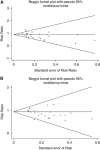Lower incidence of cerebral infarction correlates with improved functional outcome after aneurysmal subarachnoid hemorrhage
- PMID: 21505477
- PMCID: PMC3137476
- DOI: 10.1038/jcbfm.2011.56
Lower incidence of cerebral infarction correlates with improved functional outcome after aneurysmal subarachnoid hemorrhage
Abstract
Despite an undisputed association between vasospasm and delayed cerebral ischemia after aneurysmal subarachnoid hemorrhage (SAH), there is debate if this association implies causality. It has been suggested that cerebral infarction is a better outcome measure than vasospasm in clinical trials and observational studies. To further investigate the relationship between infarction and outcome, we performed a systematic review and meta-analysis of all randomized, double-blind, placebo-controlled trials that studied the efficacy of pharmaceutical preventive strategies in SAH patients, and had both cerebral infarction and clinical outcome as outcome events. Effect sizes were expressed in (pooled) risk ratio (RR) estimates with corresponding 95% confidence intervals (CIs). Sensitivity analyses were performed for studies with a low risk of bias and for those who reported outcome at 3 months after SAH. Twenty-four studies including 8,552 patients were included. Pharmaceutical treatments decreased the incidence of both cerebral infarction (RR: 0.83; 95% CI: 0.74 to 0.93) and of poor functional outcome (RR: 0.92; 95% CI: 0.86 to 0.98). The sensitivity analyses did not change the results essentially. These data suggest that the previously observed association between cerebral infarction and functional outcome implies causality, and that cerebral infarction is a better outcome measure than vasospasm in clinical trials and observational studies.
Figures



References
-
- Asano T, Takakura K, Sano K, Kikuchi H, Nagai H, Saito I, Tamura A, Ochiai C, Sasaki T. Effects of a hydroxyl radical scavenger on delayed ischemic neurological deficits following aneurysmal subarachnoid hemorrhage: results of a multicenter, placebo-controlled double-blind trial. J Neurosurg. 1996;84:792–803. - PubMed
-
- Chou SH, Smith EE, Badjatia N, Nogueira RG, Sims JR, Ogilvy CS, Rordorf GA, Ayata C. A randomized, double-blind, placebo-controlled pilot study of simvastatin in aneurysmal subarachnoid hemorrhage. Stroke. 2008;39:2891–2893. - PubMed
-
- Dreier JP, Major S, Manning A, Woitzik J, Drenckhahn C, Steinbrink J, Tolias C, Oliveira-Ferreira AI, Fabricius M, Hartings JA, Vajkoczy P, Lauritzen M, Dirnagl U, Bohner G, Strong AJ, COSBID study group Cortical spreading ischaemia is a novel process involved in ischaemic damage in patients with aneurysmal subarachnoid haemorrhage. Brain. 2009;132:1866–1881. - PMC - PubMed
-
- Dreier JP, Sakowitz OW, Harder A, Zimmer C, Dirnagl U, Valdueza JM, Unterberg AW. Focal laminar cortical MR signal abnormalities after subarachnoid hemorrhage. Ann Neurol. 2002;52:825–829. - PubMed
-
- Etminan N, Vergouwen MD, Ilodigwe D, Macdonald RL.2011Effect of pharmaceutical treatment on vasospasm, delayed cerebral ischemia and clinical outcome in patients with aneurysmal subarachnoid hemorrhage—a systematic review and meta-analysis J Cereb Blood Flow MetabEpub ahead of print 2 February 2011: PMID: 21285966 - PMC - PubMed
Publication types
MeSH terms
LinkOut - more resources
Full Text Sources
Other Literature Sources

